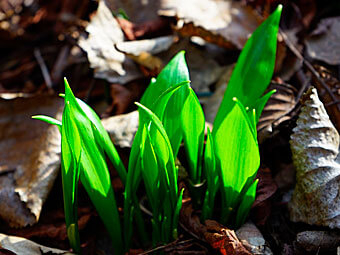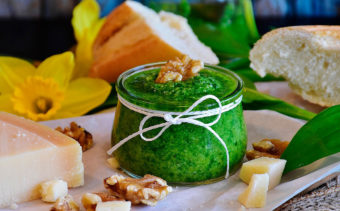
Wild garlic has only become popular in recent years and is a hit in the kitchen every spring. You should not miss the aromatic seasonal herb, because it can be used to create delicious and simple dishes. Wild garlic emerges from the snow as early as March in sheltered locations.
Wild garlic is a spring plant: the best time to harvest is from March to April, before flowering. Wild garlic is a plant species from the Allium genus and is therefore related to onions, chives and garlic. Wild garlic is also known in some areas as garlic spinach, wild garlic, forest garlic, rice garlic, dog garlic, witch’s onion or gypsy garlic. It is mostly collected for spring salads and mild garlic seasoning and is best used fresh.
Table of contents:
- Collect wild garlic: be careful! Risk of confusion with poisonous plants
- Recipe: Avocado wild garlic cream
- Recipe: Make wild garlic pesto yourself
- Preserve wild garlic
- Recipe: wild garlic butter
- Recipe: wild garlic soup
- What other names does wild garlic have?
- When does wild garlic taste best?
- Harvest wild garlic: in the morning or in the evening?
- Until when can you pick wild garlic in the forest?
- Important emergency numbers and contact addresses in the event of poisoning
- Procedure in the event of a possible poisoning accident
- Now it's your turn, your support is needed
Incidentally, ants carry away the small black seeds and thus ensure the propagation of this valuable plant. Wild garlic is most effective when fresh, i.e. in spring or throughout the year in the form of juices. Wild garlic should only be used fresh, as it loses all of its active ingredients when it dries.
The herbal pastor Künzle (* September 3, 1857 in Hinterespen near St. Gallen; † January 9, 1945 in Zizers) once wrote about wild garlic: “…probably no other herb on earth is so effective for cleaning the stomach and intestines and blood like wild garlic. Eternally ailing people, covered with ringworm, ice and rashes, the underdeveloped, the sallow and the anorexic, should worship wild garlic as gold! The young people would blossom like trellises of roses and rise like pine cones in the sun.”
Collect wild garlic: be careful! Risk of confusion with poisonous plants
Despite being easy to identify by the typical smell that arises when the leaves are rubbed, wild garlic is often confused with the poisonous leaves of the lily of the valley, the autumn crocus or the mostly undespotted leaves of younger plants of the spotted arum. These three similar plants are extremely poisonous and sometimes fatal poisoning occurs again and again. So be careful! So you have to check wild garlic carefully when collecting it, and above all: smell it: Lily of the valley leaves don’t smell! Because wild garlic smells clearly of garlic! The leaves are thinner, more tender than those of lily of the valley, and also more sensitive to pressure.
Recipe: Avocado wild garlic cream
You should have the following at home: 1 ripe avocado, 1 bunch of fresh wild garlic, 1 tablespoon of pine nuts, 1/2 tablespoon of hazelnut oil (or similar), 2 tablespoons of lemon juice, some salt and pepper.
It is prepared as follows: Halve the avocado lengthwise, twist the halves apart and remove the stone with the “knife trick”. Scoop out the halves of the avocado and mash with a fork. Wash wild garlic, spin dry and chop finely. Briefly toast the pine nuts in a pan and then chop into small pieces. Mix the avocado with wild garlic, pine nuts, lemon juice and oil and season with salt and pepper. Finished. Tip: you can also add a cup of cottage cheese or granulated cream cheese to the cream – super tasty.
Recipe: Make wild garlic pesto yourself
You should have the following at home:
1 bunch of fresh wild garlic
50 g pine nuts
50 ml good olive oil (possibly a bit more)
50 g good, grated Parmesan
a pepper mill
some salt
 It is prepared as follows: stem the wild garlic and cut into small pieces. Using an hand blender, puree with the pine nuts, which have been lightly roasted in a pan beforehand, and the good olive oil until you get an even mixture.
It is prepared as follows: stem the wild garlic and cut into small pieces. Using an hand blender, puree with the pine nuts, which have been lightly roasted in a pan beforehand, and the good olive oil until you get an even mixture.
Fold in the Parmesan and season with a little salt and pepper. The wild garlic pesto keeps in tightly closed jars in the fridge for about 1-2 weeks, in the freezer for about 3-4 months.
In short – in a good 10 minutes you have made a delicious risotto yourself.
Preserve wild garlic
I process our wild garlic in two variants – so that we can also enjoy wild garlic in summer. On the one hand I cut and chop it up, and then freeze it in a tin – so I can always take a tablespoon full, for example to make a quick wild garlic pesto (recipe see above). And on the other hand I make wild garlic butter which I fill into small glasses and freeze.
Recipe: wild garlic butter
For the wild garlic butter, stir 200 g butter with a little sea salt until the butter is very soft. Cut a handful of fresh wild garlic into very fine strips and mix into the butter. If you have wild garlic butter left over, you can simply freeze wild garlic butter – see “Preserving wild garlic”.
Recipe: wild garlic soup
You should have the following at home for 4 servings: 200 g fresh wild garlic, 1 tbsp oil, 1 onion (finely chopped), 1 carrot (crushed), 1 medium-sized potato (diced), 50 g white wine (dry), 1 l vegetable bouillon, 100 ml cream, salt and pepper.
It is prepared as follows: Wash the wild garlic thoroughly, remove the stalks and drain well. Sauté the garlic, onions and wild garlic in the oil, add the carrot and potato pieces and sauté as well. Deglaze with white wine and allow to reduce slightly. Add the vegetable stock, bring to the boil and simmer on a low “flame” for 10 – 15 minutes until the vegetables are cooked. Puree the soup carefully with a hand blender. Now fold in the whipped cream and season to taste. Tip: Scatter wild garlic leaves cut into fine strips over the soup. Finished.
What other names does wild garlic have?
Allium ursinum, known as wild garlic, cowleekes, ramsons, cows’s leek, broad-leaved garlic, wood garlic, cowleek, buckrams, bear leek, Eurasian wild garlic or bear’s garlic, is a bulbous perennial flowering plant in the amaryllis family Amaryllidaceae.
When does wild garlic taste best?
The best time to harvest wild garlic is from March to April.
Harvest wild garlic: in the morning or in the evening?
You should generally harvest wild garlic in the morning. It is then much more aromatic than in the evening. Reason: The sun and heat dry out the stems and leaves, so that the taste suffers.
Until when can you pick wild garlic in the forest?
The wild garlic season ends with the flowering period, around the beginning of May, and then loses a lot of taste.
Important emergency numbers and contact addresses in the event of poisoning
I assume no liability for the correctness of the phone numbers. Just get in touch with me if you have suggestions for changing the phone numbers!
USA:
In the United States, there is only one phone number that you need to remember:
911
This number is called for medical emergencies, but also for fire and police emergencies.
Someone will ask you a series of questions, including in any case the following:
• The location of the emergency
• The phone number you are calling from
• The nature of the emergency
• Details of the emergency
Of course, 911 should only be called in a real emergency! For example, if your children accidentally dialed the number for some reason, you shouldn’t hang up. That would be interpreted as an emergency. Instead, stay on the line and explain to the operator that there was a mistake.
Germany:
Overview of the regional poison control numbers (List of poison control centers and poison information centers in Germany, Austria and Switzerland)
e.g. B. Poison emergency call of the Berlin Charité +49 30 19240 (Day and night)
Austria:
Poison Control Center, Tel. +43(0)1-406 43 43
Switzerland:
tox center, Tel. +41(0)44-251 51 51; poison emergency call: 145
Procedure in the event of a possible poisoning accident
1. keep CALM!!!
2. Give a glass of still water, tea or juice to drink.
DO NOT induce vomiting! NO salt water! No milk!
3. Poison emergency call from the Berlin Charité +49 30 19240 (day and night) or 911 in the United States or call the one for you responsible german regional poison control center.
4. What does the poison control center need to know? More information is available on the german Berlin Charité website
Now it's your turn, your support is needed.
Did you like the post "Wild garlic: Useful tips and 3 simple recipes"?
Simply select the number of stars and click. Thank you very much for your review ![]()




